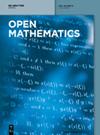求助PDF
{"title":"具有哈代势和贝里切基-狮子条件的薛定谔方程的无限多解","authors":"Shan Zhou","doi":"10.1515/math-2023-0175","DOIUrl":null,"url":null,"abstract":"In this article, we investigate the following Schrödinger equation: <jats:disp-formula> <jats:alternatives> <jats:graphic xmlns:xlink=\"http://www.w3.org/1999/xlink\" xlink:href=\"graphic/j_math-2023-0175_eq_001.png\" /> <m:math xmlns:m=\"http://www.w3.org/1998/Math/MathML\" display=\"block\"> <m:mo>−</m:mo> <m:mi mathvariant=\"normal\">Δ</m:mi> <m:mi>u</m:mi> <m:mo>−</m:mo> <m:mfrac> <m:mrow> <m:mi>μ</m:mi> </m:mrow> <m:mrow> <m:msup> <m:mrow> <m:mo>∣</m:mo> <m:mi>x</m:mi> <m:mo>∣</m:mo> </m:mrow> <m:mrow> <m:mn>2</m:mn> </m:mrow> </m:msup> </m:mrow> </m:mfrac> <m:mi>u</m:mi> <m:mo>=</m:mo> <m:mi>g</m:mi> <m:mrow> <m:mo>(</m:mo> <m:mrow> <m:mi>u</m:mi> </m:mrow> <m:mo>)</m:mo> </m:mrow> <m:mspace width=\"1em\" /> <m:mi mathvariant=\"normal\">in</m:mi> <m:mspace width=\"0.33em\" /> <m:msup> <m:mrow> <m:mi mathvariant=\"double-struck\">R</m:mi> </m:mrow> <m:mrow> <m:mi>N</m:mi> </m:mrow> </m:msup> <m:mo>,</m:mo> </m:math> <jats:tex-math>-\\Delta u-\\frac{\\mu }{{| x| }^{2}}u=g\\left(u)\\hspace{1em}{\\rm{in}}\\hspace{0.33em}{{\\mathbb{R}}}^{N},</jats:tex-math> </jats:alternatives> </jats:disp-formula> where <jats:inline-formula> <jats:alternatives> <jats:inline-graphic xmlns:xlink=\"http://www.w3.org/1999/xlink\" xlink:href=\"graphic/j_math-2023-0175_eq_002.png\" /> <m:math xmlns:m=\"http://www.w3.org/1998/Math/MathML\"> <m:mi>N</m:mi> <m:mo>≥</m:mo> <m:mn>3</m:mn> </m:math> <jats:tex-math>N\\ge 3</jats:tex-math> </jats:alternatives> </jats:inline-formula>, <jats:inline-formula> <jats:alternatives> <jats:inline-graphic xmlns:xlink=\"http://www.w3.org/1999/xlink\" xlink:href=\"graphic/j_math-2023-0175_eq_003.png\" /> <m:math xmlns:m=\"http://www.w3.org/1998/Math/MathML\"> <m:mfrac> <m:mrow> <m:mi>μ</m:mi> </m:mrow> <m:mrow> <m:msup> <m:mrow> <m:mo>∣</m:mo> <m:mi>x</m:mi> <m:mo>∣</m:mo> </m:mrow> <m:mrow> <m:mn>2</m:mn> </m:mrow> </m:msup> </m:mrow> </m:mfrac> </m:math> <jats:tex-math>\\frac{\\mu }{{| x| }^{2}}</jats:tex-math> </jats:alternatives> </jats:inline-formula> is called the Hardy potential and <jats:inline-formula> <jats:alternatives> <jats:inline-graphic xmlns:xlink=\"http://www.w3.org/1999/xlink\" xlink:href=\"graphic/j_math-2023-0175_eq_004.png\" /> <m:math xmlns:m=\"http://www.w3.org/1998/Math/MathML\"> <m:mi>g</m:mi> </m:math> <jats:tex-math>g</jats:tex-math> </jats:alternatives> </jats:inline-formula> satisfies Berestycki-Lions conditions. If <jats:inline-formula> <jats:alternatives> <jats:inline-graphic xmlns:xlink=\"http://www.w3.org/1999/xlink\" xlink:href=\"graphic/j_math-2023-0175_eq_005.png\" /> <m:math xmlns:m=\"http://www.w3.org/1998/Math/MathML\"> <m:mn>0</m:mn> <m:mo><</m:mo> <m:mi>μ</m:mi> <m:mo><</m:mo> <m:mfrac> <m:mrow> <m:msup> <m:mrow> <m:mrow> <m:mo>(</m:mo> <m:mrow> <m:mi>N</m:mi> <m:mo>−</m:mo> <m:mn>2</m:mn> </m:mrow> <m:mo>)</m:mo> </m:mrow> </m:mrow> <m:mrow> <m:mn>2</m:mn> </m:mrow> </m:msup> </m:mrow> <m:mrow> <m:mn>4</m:mn> </m:mrow> </m:mfrac> </m:math> <jats:tex-math>0\\lt \\mu \\lt \\frac{{\\left(N-2)}^{2}}{4}</jats:tex-math> </jats:alternatives> </jats:inline-formula>, we will take symmetric mountain pass approaches to prove the existence of infinitely many solutions of this problem.","PeriodicalId":48713,"journal":{"name":"Open Mathematics","volume":"23 1","pages":""},"PeriodicalIF":1.0000,"publicationDate":"2024-03-22","publicationTypes":"Journal Article","fieldsOfStudy":null,"isOpenAccess":false,"openAccessPdf":"","citationCount":"0","resultStr":"{\"title\":\"Infinitely many solutions for Schrödinger equations with Hardy potential and Berestycki-Lions conditions\",\"authors\":\"Shan Zhou\",\"doi\":\"10.1515/math-2023-0175\",\"DOIUrl\":null,\"url\":null,\"abstract\":\"In this article, we investigate the following Schrödinger equation: <jats:disp-formula> <jats:alternatives> <jats:graphic xmlns:xlink=\\\"http://www.w3.org/1999/xlink\\\" xlink:href=\\\"graphic/j_math-2023-0175_eq_001.png\\\" /> <m:math xmlns:m=\\\"http://www.w3.org/1998/Math/MathML\\\" display=\\\"block\\\"> <m:mo>−</m:mo> <m:mi mathvariant=\\\"normal\\\">Δ</m:mi> <m:mi>u</m:mi> <m:mo>−</m:mo> <m:mfrac> <m:mrow> <m:mi>μ</m:mi> </m:mrow> <m:mrow> <m:msup> <m:mrow> <m:mo>∣</m:mo> <m:mi>x</m:mi> <m:mo>∣</m:mo> </m:mrow> <m:mrow> <m:mn>2</m:mn> </m:mrow> </m:msup> </m:mrow> </m:mfrac> <m:mi>u</m:mi> <m:mo>=</m:mo> <m:mi>g</m:mi> <m:mrow> <m:mo>(</m:mo> <m:mrow> <m:mi>u</m:mi> </m:mrow> <m:mo>)</m:mo> </m:mrow> <m:mspace width=\\\"1em\\\" /> <m:mi mathvariant=\\\"normal\\\">in</m:mi> <m:mspace width=\\\"0.33em\\\" /> <m:msup> <m:mrow> <m:mi mathvariant=\\\"double-struck\\\">R</m:mi> </m:mrow> <m:mrow> <m:mi>N</m:mi> </m:mrow> </m:msup> <m:mo>,</m:mo> </m:math> <jats:tex-math>-\\\\Delta u-\\\\frac{\\\\mu }{{| x| }^{2}}u=g\\\\left(u)\\\\hspace{1em}{\\\\rm{in}}\\\\hspace{0.33em}{{\\\\mathbb{R}}}^{N},</jats:tex-math> </jats:alternatives> </jats:disp-formula> where <jats:inline-formula> <jats:alternatives> <jats:inline-graphic xmlns:xlink=\\\"http://www.w3.org/1999/xlink\\\" xlink:href=\\\"graphic/j_math-2023-0175_eq_002.png\\\" /> <m:math xmlns:m=\\\"http://www.w3.org/1998/Math/MathML\\\"> <m:mi>N</m:mi> <m:mo>≥</m:mo> <m:mn>3</m:mn> </m:math> <jats:tex-math>N\\\\ge 3</jats:tex-math> </jats:alternatives> </jats:inline-formula>, <jats:inline-formula> <jats:alternatives> <jats:inline-graphic xmlns:xlink=\\\"http://www.w3.org/1999/xlink\\\" xlink:href=\\\"graphic/j_math-2023-0175_eq_003.png\\\" /> <m:math xmlns:m=\\\"http://www.w3.org/1998/Math/MathML\\\"> <m:mfrac> <m:mrow> <m:mi>μ</m:mi> </m:mrow> <m:mrow> <m:msup> <m:mrow> <m:mo>∣</m:mo> <m:mi>x</m:mi> <m:mo>∣</m:mo> </m:mrow> <m:mrow> <m:mn>2</m:mn> </m:mrow> </m:msup> </m:mrow> </m:mfrac> </m:math> <jats:tex-math>\\\\frac{\\\\mu }{{| x| }^{2}}</jats:tex-math> </jats:alternatives> </jats:inline-formula> is called the Hardy potential and <jats:inline-formula> <jats:alternatives> <jats:inline-graphic xmlns:xlink=\\\"http://www.w3.org/1999/xlink\\\" xlink:href=\\\"graphic/j_math-2023-0175_eq_004.png\\\" /> <m:math xmlns:m=\\\"http://www.w3.org/1998/Math/MathML\\\"> <m:mi>g</m:mi> </m:math> <jats:tex-math>g</jats:tex-math> </jats:alternatives> </jats:inline-formula> satisfies Berestycki-Lions conditions. If <jats:inline-formula> <jats:alternatives> <jats:inline-graphic xmlns:xlink=\\\"http://www.w3.org/1999/xlink\\\" xlink:href=\\\"graphic/j_math-2023-0175_eq_005.png\\\" /> <m:math xmlns:m=\\\"http://www.w3.org/1998/Math/MathML\\\"> <m:mn>0</m:mn> <m:mo><</m:mo> <m:mi>μ</m:mi> <m:mo><</m:mo> <m:mfrac> <m:mrow> <m:msup> <m:mrow> <m:mrow> <m:mo>(</m:mo> <m:mrow> <m:mi>N</m:mi> <m:mo>−</m:mo> <m:mn>2</m:mn> </m:mrow> <m:mo>)</m:mo> </m:mrow> </m:mrow> <m:mrow> <m:mn>2</m:mn> </m:mrow> </m:msup> </m:mrow> <m:mrow> <m:mn>4</m:mn> </m:mrow> </m:mfrac> </m:math> <jats:tex-math>0\\\\lt \\\\mu \\\\lt \\\\frac{{\\\\left(N-2)}^{2}}{4}</jats:tex-math> </jats:alternatives> </jats:inline-formula>, we will take symmetric mountain pass approaches to prove the existence of infinitely many solutions of this problem.\",\"PeriodicalId\":48713,\"journal\":{\"name\":\"Open Mathematics\",\"volume\":\"23 1\",\"pages\":\"\"},\"PeriodicalIF\":1.0000,\"publicationDate\":\"2024-03-22\",\"publicationTypes\":\"Journal Article\",\"fieldsOfStudy\":null,\"isOpenAccess\":false,\"openAccessPdf\":\"\",\"citationCount\":\"0\",\"resultStr\":null,\"platform\":\"Semanticscholar\",\"paperid\":null,\"PeriodicalName\":\"Open Mathematics\",\"FirstCategoryId\":\"100\",\"ListUrlMain\":\"https://doi.org/10.1515/math-2023-0175\",\"RegionNum\":4,\"RegionCategory\":\"数学\",\"ArticlePicture\":[],\"TitleCN\":null,\"AbstractTextCN\":null,\"PMCID\":null,\"EPubDate\":\"\",\"PubModel\":\"\",\"JCR\":\"Q1\",\"JCRName\":\"MATHEMATICS\",\"Score\":null,\"Total\":0}","platform":"Semanticscholar","paperid":null,"PeriodicalName":"Open Mathematics","FirstCategoryId":"100","ListUrlMain":"https://doi.org/10.1515/math-2023-0175","RegionNum":4,"RegionCategory":"数学","ArticlePicture":[],"TitleCN":null,"AbstractTextCN":null,"PMCID":null,"EPubDate":"","PubModel":"","JCR":"Q1","JCRName":"MATHEMATICS","Score":null,"Total":0}
引用次数: 0
引用
批量引用
Infinitely many solutions for Schrödinger equations with Hardy potential and Berestycki-Lions conditions
In this article, we investigate the following Schrödinger equation: − Δ u − μ ∣ x ∣ 2 u = g ( u ) in R N , -\Delta u-\frac{\mu }{{| x| }^{2}}u=g\left(u)\hspace{1em}{\rm{in}}\hspace{0.33em}{{\mathbb{R}}}^{N}, where N ≥ 3 N\ge 3 , μ ∣ x ∣ 2 \frac{\mu }{{| x| }^{2}} is called the Hardy potential and g g satisfies Berestycki-Lions conditions. If 0 < μ < ( N − 2 ) 2 4 0\lt \mu \lt \frac{{\left(N-2)}^{2}}{4} , we will take symmetric mountain pass approaches to prove the existence of infinitely many solutions of this problem.


